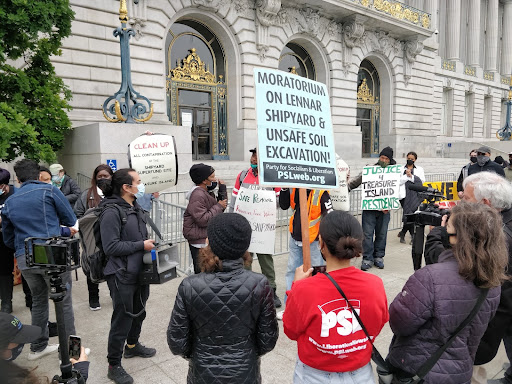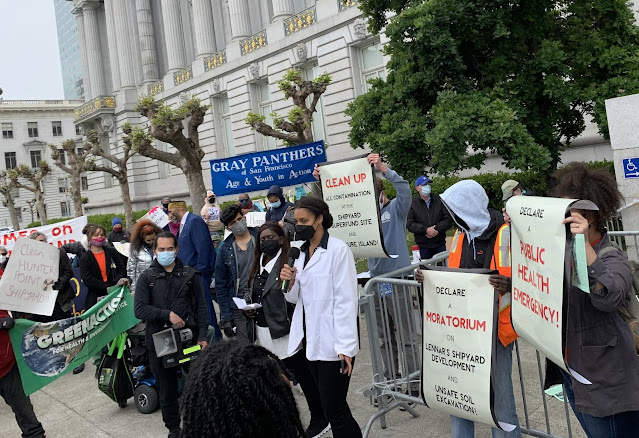By Declan Bernal and Emily Pachoud

April 2021 People’s Earth Day Rally at San Francisco City Hall. Credit: Declan Bernal
Bayview Hunters Point (BVHP) and Treasure Island are two low-income communities in San Francisco made up of primarily BIPOC residents that are disproportionately burdened with pollution sources and toxic contamination. Lennar Corporation—one of the largest developers in the nation—has begun construction of houses next to the former Hunters Point Naval Shipyard—one of the largest Superfund sites in the US—which remains contaminated with radioactive materials. Despite residents being told that the site would be fully cleaned up and safe to live in, numerous incidents have rightfully sowed seeds of doubt in the minds of the public. Some of these incidents include two employees of Tetra Tech EC—the contractor charged with testing soil at Hunters Point for radiation—being found guilty of falsifying results, as well as the Navy choosing to cover up and bury the contamination rather than remove it. According to an EPA review, as much as 97% of the cleanup data is “neither reliable nor defensible,” but the US Navy and the state of California have nonetheless claimed that there is no health risk.
Last April, we attended the People’s Earth Day Rally in front of the San Francisco City Hall alongside activists, community members, and Bayview Hunters Point and Treasure Island residents to call for a moratorium on Lennar’s Shipyard development, the declaration of a public health emergency, and the full retesting and cleanup of the Shipyard Superfund site and Treasure Island. While there, numerous individuals told stories of the health issues caused by the contamination in their communities and how their pleas to local government officials have been ignored, while the powerful financial interests of Lennar Corporation continue to hold sway. When there is profit to be made, the concerns of low-income minority communities are seemingly easy for the City Council to ignore.

April 2021 People’s Earth Day Rally at San Francisco City Hall. Credit: Declan Bernal
Suffice to say, it is essential for people, especially us as students, to speak up about this situation and support the residents who are fighting this environmental racism. Public outcry can help to put pressure on the local government and the developers to address these environmental injustices and, in the case of Lennar’s shipyard, stop the development and fully clean up all contamination. Being a part of the Environmental Justice Advocacy Lab provides SCU students with opportunities to get directly involved in efforts that we are passionate about, going beyond just learning about these issues and discussing them in classrooms or other settings. Viewing these problems through a purely academic lens can obfuscate how these issues actually impact people’s lives in the real world. Having discussions about EJ issues is naturally very important as well, but the real change comes about from collective action.

April 2021 People’s Earth Day Rally at San Francisco City Hall. Credit: Declan Bernal
In numerous classes at SCU, we talk about environmental justice and examples of injustices but many students are not sure where to go from there. We were fortunate enough to learn about the People’s Earth Day Rally through the Environmental Justice Advocacy Lab. The EJ Advocacy Lab brings together undergraduate students like us as well as graduate students from all over SCU, faculty, and community groups like the Bayview Hunters Point Mothers and Fathers Committee and Greenaction to work together to solve environmental injustice. Thanks to the EJ Advocacy Lab, not only did we get to attend the rally, but we were also able to help community groups do research on the criteria and responsible parties for declaring public health emergencies. We also designed some of the posters that were used at the rally.
Attending protests like the People’s Earth Day Rally, taking legal action against those who are responsible for environmental injustices, and directly supporting the impacted communities are effective forms of action that students have the ability to take part in. The EJ Advocacy Lab helps us find us these real, solid actions to take that also give us the chance to dip our toes into environmental justice law, which is very exciting for those of us who are considering that path in the future.